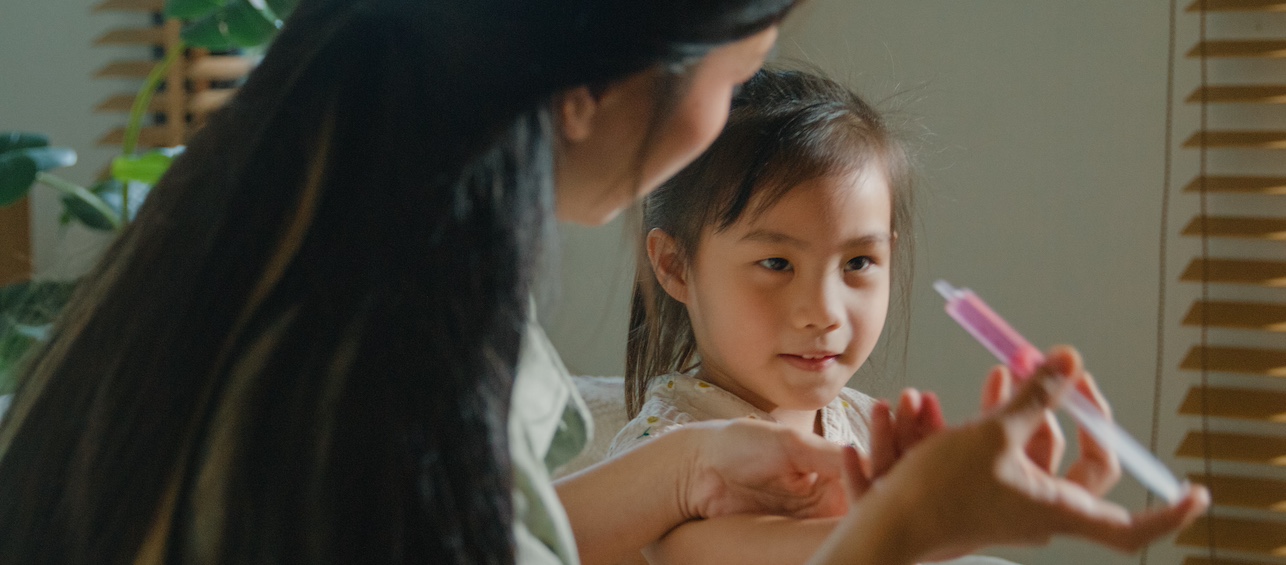As many parents can probably attest, giving medications to kids can be challenging.
For some kids, the medication tastes yucky to them and they refuse to take it. From the parent perspective, giving the proper dose can be tricky, especially when it’s 2 a.m. and 0.5 mL looks like 5 mL (1 teaspoon) in the dark.
Be Sure to Measure Medications Properly
Turning on the lights and taking a moment to accurately measure the proper amount of medication for your child in the appropriate dosage device could prevent a potential overdose. In one study, the American Academy of Pediatrics found that 41% of parents made a dosage error when administering medications to their children.
At the Cincinnati Drug and Poison Information Center, we receive many calls about drug overdose related to improper measuring every day. It typically happens when caregivers don’t read the directions before giving the dose, or when an improper dosing device is used. Sometimes parents leave the medicine within reach of the child after giving a dose and the child can get into it, or two different caregivers both give a dose within minutes of each other.
I recommend the following medication safety tips to help prevent accidental drug overdose in kids.
Tips to Safely Administer Medicine to Children
1. Use the measuring device (i.e. syringes and cups) that came with the medication.
I like to keep the original box that the medication came in. That way I can keep the measuring device right there with the medication and it won’t get lost or tossed in the trash can. If the medication did not come with a measuring device, ask your pharmacist for one.
Do not use household spoons. Spoons come in many different sizes and it’s just too easy to measure inaccurately.
2. Re-read the label each time.
It’s important to re-read the label each time so that you dispense the medication as instructed. This may sound obvious, but in the middle of the night it can be tempting to go by memory to save time. Be sure to turn your lights on, too.
3. Know the active ingredients.
Many over-the-counter products contain multiple active ingredients. Do not give more than one medication with the same active ingredient.
4. Be aware of the type or formulation of medicine.
There are many infant and children’s medications available on store shelves. Infant medications are generally more concentrated than children’s formulations. Double check to make sure you are giving the correct formulation for your child.
5. Write down the time you gave your child their medication.
Life is busy, especially with a sick child or children. Writing down the time you gave the dose of medication will help keep you on track and avoid too much or too little medication being given.
Keep track of the doses with a marker directly on the bottle. Or try an app such as Pill Monitor, Dosecast and Pill Alert Pro.
6. Don’t allow your child to drink directly from the bottle.
Even if it is an over-the-counter medication or a natural remedy, it is still important to measure accurately.
7. Use caution with flavored medications.
Some manufacturers offer a variety of tasty flavors of medication, including chocolate. While this may be helpful for those times when you want your child to take medication, children may be tempted to get into those medications on their own and an accidental overdose could occur.
8. Do not call medicine “candy.”
It can be tempting to make the medicine sound appealing to your child, but at the same time, you don’t want them to be eager to take an extra dose when they’re not supposed to.
If your child needs to take a medication in pill form and they’re having a hard time, read this blog post: Tips for Teaching Kids How to Swallow Pills.
9. Keep all drugs out of the reach of children, or better yet, locked.
Parents are busy and it can be difficult to remember to give your child their medication when you have a lot of other things going on. I recommend setting an alarm on your phone, rather than leaving it on the counter in plain sight (or your child’s reach) so that you’ll remember it.
10. Know your child’s weight.
Pediatric medications are typically dosed based on your child’s weight. It is important for you to know exactly how much your child weighs, especially if you are figuring out the dose of an over-the-counter medication. If you are not sure how much your child weighs, be sure to put them on an accurate scale prior to giving them medication. Remember, the dosage may be different for each child, depending on their weight.

I suggest that parents put the Drug and Poison Information Center number 1-800-222-1222 in their cell phones and near every home phone for emergency situations. You can also scan the QR code below and the poison control number will be programmed automatically into your cell phone or mobile device.
If you think you might have given your child an improper dose of a medication or even if you are confused about how to measure or give your child’s dose, give us a call. We are here 24 hours a day, 7 days a week, to answer your drug dosage questions.






Couldn’t pharmaceutical manufacturers mark the dispensing markers/droppers in ways like this: draw a bar and under it indicate something like, “typical dose for 10 to 20 lb. patient.” Under that a second line labeled something like, “typical dose for a 21-35 lb. patient.” This would provide a secondary safeguard. If necessary for adequate sized print the dropper could be made with a larger surface to accommodate extra printing and bottles could be made with slightly larger openings to fit the larger droppers.